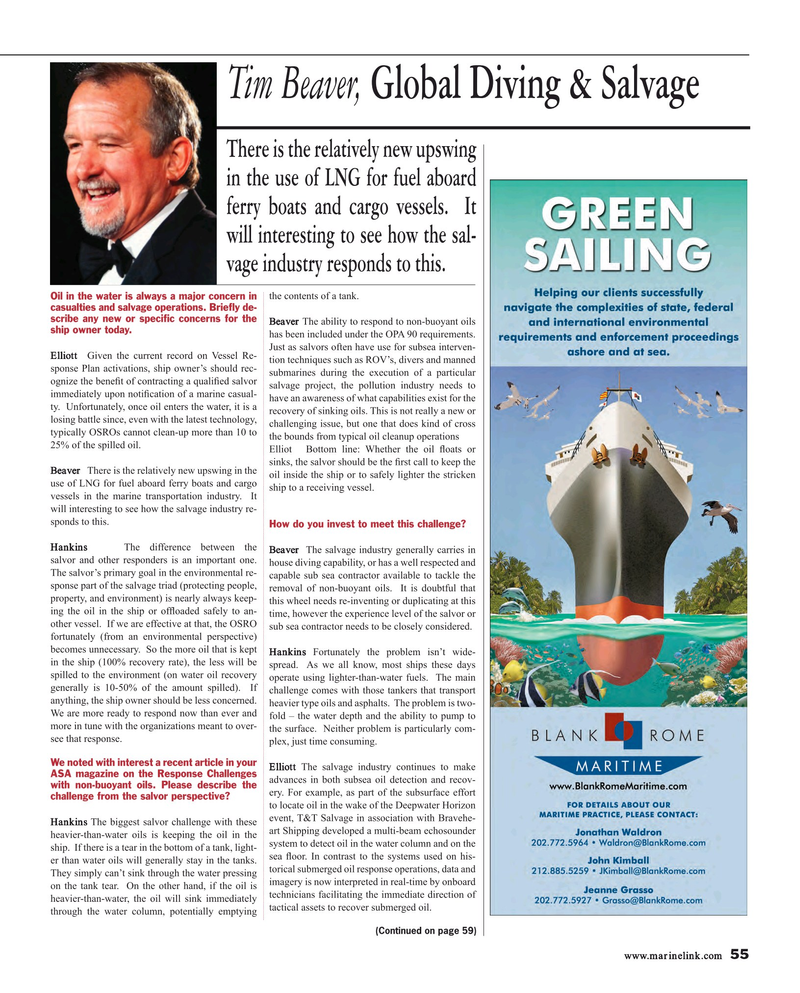
Page 55: of Maritime Reporter Magazine (March 2015)
U.S. Coast Guard Annual
Read this page in Pdf, Flash or Html5 edition of March 2015 Maritime Reporter Magazine
Tim Beaver, Global Diving & Salvage
There is the relatively new upswing in the use of LNG for fuel aboard ferry boats and cargo vessels. It will interesting to see how the sal- vage industry responds to this.
the contents of a tank.
Oil in the water is always a major concern in casualties and salvage operations. Brie? y de- scribe any new or speci? c concerns for the
Beaver The ability to respond to non-buoyant oils ship owner today. has been included under the OPA 90 requirements.
Just as salvors often have use for subsea interven-
Elliott Given the current record on Vessel Re- tion techniques such as ROV’s, divers and manned sponse Plan activations, ship owner’s should rec- submarines during the execution of a particular ognize the bene? t of contracting a quali? ed salvor salvage project, the pollution industry needs to immediately upon noti? cation of a marine casual- have an awareness of what capabilities exist for the ty. Unfortunately, once oil enters the water, it is a recovery of sinking oils. This is not really a new or losing battle since, even with the latest technology, challenging issue, but one that does kind of cross typically OSROs cannot clean-up more than 10 to the bounds from typical oil cleanup operations 25% of the spilled oil.
Elliot Bottom line: Whether the oil ? oats or sinks, the salvor should be the ? rst call to keep the
Beaver There is the relatively new upswing in the oil inside the ship or to safely lighter the stricken use of LNG for fuel aboard ferry boats and cargo ship to a receiving vessel. vessels in the marine transportation industry. It will interesting to see how the salvage industry re- sponds to this.
How do you invest to meet this challenge?
Hankins The difference between the Beaver The salvage industry generally carries in salvor and other responders is an important one. house diving capability, or has a well respected and
The salvor’s primary goal in the environmental re- capable sub sea contractor available to tackle the sponse part of the salvage triad (protecting people, removal of non-buoyant oils. It is doubtful that property, and environment) is nearly always keep- this wheel needs re-inventing or duplicating at this ing the oil in the ship or of? oaded safely to an- time, however the experience level of the salvor or other vessel. If we are effective at that, the OSRO sub sea contractor needs to be closely considered. fortunately (from an environmental perspective) becomes unnecessary. So the more oil that is kept Hankins Fortunately the problem isn’t wide- in the ship (100% recovery rate), the less will be spread. As we all know, most ships these days spilled to the environment (on water oil recovery operate using lighter-than-water fuels. The main generally is 10-50% of the amount spilled). If challenge comes with those tankers that transport anything, the ship owner should be less concerned. heavier type oils and asphalts. The problem is two-
We are more ready to respond now than ever and fold – the water depth and the ability to pump to more in tune with the organizations meant to over- the surface. Neither problem is particularly com- see that response. plex, just time consuming.
We noted with interest a recent article in your
Elliott The salvage industry continues to make
ASA magazine on the Response Challenges advances in both subsea oil detection and recov- with non-buoyant oils. Please describe the ery. For example, as part of the subsurface effort challenge from the salvor perspective?
to locate oil in the wake of the Deepwater Horizon
Hankins The biggest salvor challenge with these event, T&T Salvage in association with Bravehe- heavier-than-water oils is keeping the oil in the art Shipping developed a multi-beam echosounder system to detect oil in the water column and on the ship. If there is a tear in the bottom of a tank, light- er than water oils will generally stay in the tanks. sea ? oor. In contrast to the systems used on his- torical submerged oil response operations, data and
They simply can’t sink through the water pressing on the tank tear. On the other hand, if the oil is imagery is now interpreted in real-time by onboard heavier-than-water, the oil will sink immediately technicians facilitating the immediate direction of through the water column, potentially emptying tactical assets to recover submerged oil. (Continued on page 59) www.marinelink.com 55
MR #3 (50-57).indd 55 MR #3 (50-57).indd 55 3/6/2015 3:09:00 PM3/6/2015 3:09:00 PM

 54
54

 56
56
